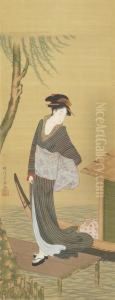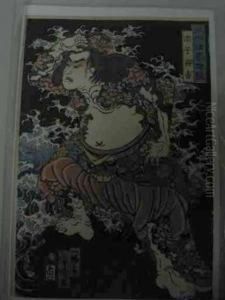Utagawa Yoshiharu Paintings
Utagawa Yoshiharu was a Japanese ukiyo-e artist who lived during the late Edo period and early Meiji period. He was born in 1828 and passed away in 1888. Yoshiharu was a student of Utagawa Kuniyoshi, one of the last great masters of the ukiyo-e genre of woodblock prints and paintings. He was part of the Utagawa school, which was a prolific group of artists who produced works in a wide range of genres and styles.
Yoshiharu is best known for his yakusha-e (actor prints) and his depictions of scenes from kabuki theatre. These works often featured portraits of famous kabuki actors in various roles, showcasing Yoshiharu’s ability to capture the drama and emotion of the theatrical performances. He also produced musha-e (warrior prints), which depicted historical and legendary samurai in battle scenes or dramatic poses.
During his career, Yoshiharu witnessed the transition from the traditional Edo period to the modernizing Meiji period. This period of Japanese history was characterized by the country opening up to the West after more than two centuries of relative isolation, and the art world was influenced by the influx of Western culture and technology. However, Yoshiharu's work remained rooted in the traditional subjects and styles of ukiyo-e.
Yoshiharu's prints are characterized by their vivid colors and dynamic compositions. Like many ukiyo-e artists, he worked closely with woodblock carvers and printers to create his prints. The collaborative nature of ukiyo-e production meant that the final works were a result of the combined skills of multiple craftsmen.
While Utagawa Yoshiharu may not be as well-known as some of his contemporaries, his contributions to the world of Japanese woodblock prints have been appreciated by collectors and scholars of Japanese art. His works capture a unique moment in Japan’s cultural history, bridging the gap between the traditional and the modern.

